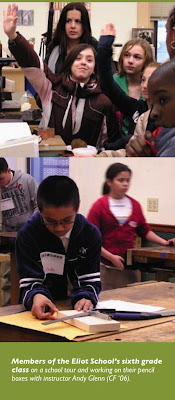
At Clear Spring School this morning, the first, second and third grade students made tops. They are simple, they are fun. We follow these steps:
1. Use a pencil sharpener to put a sharp point on a dowel.
2. Then use a hand saw to cut it to length. I've made a special centering jig on the drill press that holds a short piece of large dowel at exact center for drilling.
3. I clamp the work piece in place while the child drills.
4. Next glue the small dowel in place.
Each child made enough tops to fill their pockets, so you can imagine how much fun they had. They used markers and cut paper to do designs on the top and sides and also practiced their top spinning technique. This may have been the "most fun project" of the whole year.
In my own shop, I continue to work on the miniature walnut chest of drawers, and you can see the results of my tapering of sides in the photo above. As you can see, I am making two.
I am also busy setting up for the White Street Art Walk this next Friday night. May is Fine Arts Festival month in Eureka Springs. I also have work on exhibition in a special showing of local art at the Queen Anne Mansion.
In the meantime, the Eureka Springs Public High School is currently refusing to allow a jewelry making class to take place because the students would use propane torches. According to reports, the administration thinks that hot torches would be too dangerous for high school age students. The students can't be trusted with such dangerous tools.
Arts boosters in the community are hoping to take this issue up with the school board. Even though I no longer have a child in school, I've been asked to join the arts booster club to try to encourage creative opportunities for all students. Children are seriously injured each year playing basketball, but doing something far less dangerous and creative using sharp or hot objects is not allowed.
Is it any wonder we are becoming a nation of idiots? Is it any wonder that creatively inclined children drop out of school before graduation? Children are seriously injured by our failure to put tools of creative expression in their hands. They are also injured in spirit by our failure to trust. As I've mentioned before in the blog, we allow them to text message while driving which is far more dangerous than anything they could possibly do in schools.
This morning I was again thinking about the German expression,
fingerspitzengefühl, which means having full command of something as though it is all present at one's fingertips.
Fingerspitzengefühl was a term applied to famous German generals like Rommel, the Desert Fox, who seemed to have a supernatural sense of the entire field of battle. Is there a relationship between intuition and the use of the hands? I suspect that hands-on learning does foster intuition. After all, when we know someone is clue-less, we say they are out of touch.
In Swedish, the term
tummen mitt i handen “a thumb in the middle of your hand” — is a rough analogue to the English idiom “all thumbs,” and refers to physical clumsiness. On the other hand,
fingerspitzengefühl is a term which refers to much more than simple dexterity.




 I am in West Palm Beach, Florida, and my readers had asked about whether or not sawdust would remove oil from sea water. My readers had also inquired whether or not it would work with heavier viscosity oil, like one would encounter in crude. So this is my test. Water from the sea, chain saw oil, water, and sawdust from the local Home Depot.
I am in West Palm Beach, Florida, and my readers had asked about whether or not sawdust would remove oil from sea water. My readers had also inquired whether or not it would work with heavier viscosity oil, like one would encounter in crude. So this is my test. Water from the sea, chain saw oil, water, and sawdust from the local Home Depot.











































